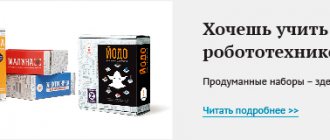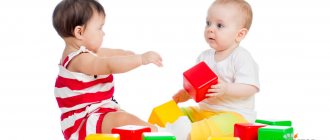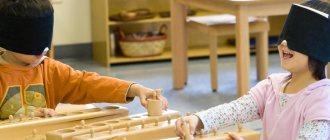Diagnostics of the thinking of preschool children
In preschool age (3-6 years), children absorb knowledge about the world around them like a sponge. The larger their areolas of cognition, the more characteristics of surrounding objects they know and the more synonyms they can present.
Types of thinking characteristic of preschoolers:
- visually effective (up to 3 years) – is expressed in the fact that recognition of the properties of an object occurs through physical contact with it;
- visual-figurative (from 3 to 5 years) - during this period the child is already able to operate with images of objects without having them at hand, to replace some objects with others in the game;
- verbal-logical (5–6 years old) – children learn to operate with abstract concepts, without the use of visual aids, relying on reasoning and evidence.
In preschool age, of the three types of thinking described, the first two are the most developed; verbal-logical thinking is just beginning to develop. That is why in tasks for preschoolers images of objects should be used, and not their verbal designations.
Test "Find the differences"
Reveals the level of development of observation skills.
Prepare two identical pictures, differing from each other in 5-10 details (such tasks are found in children's magazines and educational copybooks).
The child looks at the pictures for 1-2 minutes, then talks about the differences he found. A preschool child with a high level of observation must find all the differences.
Methods for diagnosing thinking in preschool children
Visual-effective thinking is diagnosed in preschoolers using fairly simple techniques, such as, for example, Seguin boards, “Mailbox”, etc.
Diagnostics of visual-figurative thinking
“Nonsense” technique
The technique is aimed at identifying the child’s understanding of the simplest connections, the relationship between animals and nature, as well as his ability to reason logically. The technique consists of presenting the subject with a picture depicting animals in absurd situations, the child needs to point out the inconsistencies, explaining what is wrong, then he needs to tell how this or that character should behave correctly. You have 3 minutes to complete the task.
If during this time the child finds all 7 absurdities depicted and manages to tell how it should really be, he receives the highest score, confirming a high level of visual-figurative thinking. When a subject fails to find more than four inconsistencies in a drawing, this indicates poorly developed visual-figurative thinking.
Trace the outline
As material, figures are given, only half of which are shown in outline in the figure. The goal is to accurately replicate the left half of the image on the right side. Based on the results of the work, the speed of its completion, accuracy (the outlines of the figures are depicted in the same places as on the left side, the corners are accurately connected) and accuracy (the lines are drawn straight) are assessed. The highest score is given to children who spent less than 90 seconds on the work and completed their half of the image, accurately repeating the sample. The lowest score is awarded to preschoolers who complete the task in more than 150 seconds if the lines are not straight and the angles are connected incorrectly.
Finding the missing parts of the picture among those offered to choose from
In tasks of this type, the preschooler must find the missing fragment. Considering that most of the image is given, the child should have a complete image, based on which he can find the missing fragment like a puzzle. There are similar tasks where only part of the image is given and you need to understand what kind of whole image is hidden behind it.
Drawings on the topic of traffic rules in kindergartens - safety through the eyes of children
Tasks to find objects united by some common feature (generalization and classification)
In this type of task, it is proposed to combine objects according to image and likeness or functionality into groups or sort them according to the same criteria. For example, you are given a set of items, among which you need to find something that can be useful at school or on a hike, something that a doctor or cook uses. Children are also asked to combine drawings into pairs according to their purpose (for example, fork + knife), color (tomato + strawberry), shape (ball + orange), relationship (saw + log), etc.
Tasks to find patterns
In such tasks, you are given a series with repeating objects, the pattern of alternation of which you need to catch (leaf, flower, leaf, skip, leaf) or a series where the object changes incrementally and you need to guess what it will look like on a certain segment of the path (circle - circle with arrows - hours), etc.
Fourth wheel
The tasks contain images of objects, among which you need to find one extra one. The remaining pictures need to be combined under one name. For three-year-old children, this could be a set: fox, hare, ball, wolf (an extra ball, the rest are animals). Further, the task becomes more complicated, for example, drawings are given: a fox, a hare, a giraffe, a wolf (an extra giraffe, since the rest of the animals live in the forest).
Diagnosis of creative thinking
It is a recognized fact: creativity is more a process than an end product. A creative approach to business means setting a problem for yourself and finding ways to best solve it.
That is why a person with creative abilities is distinguished by a strong need to learn new things. A high level of cognitive activity begins to manifest itself at an early age, when the child is just beginning to explore the world. It’s easy to see its manifestations by watching the baby:
- emotional reactions to new toys, objects, situations manifest themselves vividly and find a positive response to changes;
- great interest is shown in new people, ways of behavior, knowledge;
- high need for imitation, repetition of heard words and actions.
Questions from creatively inclined children can come as a surprise to parents and cause confusion, because... The inquisitive minds of children delve deeper into the question of interest. At age 5, inquisitive minds begin to conduct experiments, trying to find answers on their own. Also, at 5-6 years old, the growing level of need to understand the world around us pushes the child to try to answer his own questions. The search for solutions to problems is carried out systematically and consistently. Closer to primary school age, the child has a need to share his discoveries with his immediate environment.
To assess the creative abilities of children in psychology, a number of criteria identified by the American scientist P. Torrence are used:
- productivity;
- flexibility;
- originality;
- development of creative ideas and solutions.
To assess the creative abilities of preschool children, methods are used that give room for imagination; in the process of working on a task, the child can express himself and reveal his creative potential.
Methods for diagnosing the creative abilities of preschool children
Methodology for evaluating a fairy tale written by a child by O.M. Dyachenko and E.L. Porotskaya
During the study, children are asked to compose their own fairy tale, then its productivity, originality and variability are assessed. The lowest score is given to participants who refuse the proposed task or retell a well-known fairy tale. The highest score goes to children who managed to independently come up with a fairy tale and present it in detail.
P. Torrance test for creative thinking (adapted by N.B. Shumakova, E.I. Shcheblanova, N.P. Shcherbo)
The method contains two figures (a drop and a bean), a form with unfinished contours of images and a form with repeating lines, which are used to solve three problems (each takes 10 minutes):
- “Draw a picture” - test shapes are used to create a picture. The original forms can be supplemented with the necessary details, and then you need to come up with a name for the resulting picture.
- “Unfinished Shapes” - the child is asked to imagine what the original 10 unfinished shapes might look like. Each of them is tied to a stable image, but the more creative the created image, the more creative the preschooler’s thinking is. Each completed picture must be given a title.
- “Repeating figures” - the preschooler is given a form on which repeating paired lines are depicted. From each pair of lines you need to create a drawing. For this task, it is important to draw without repetition, coming up with different images.
Evaluation of completed work is carried out taking into account productivity, flexibility, originality and detail of completed tasks.
Creative task “Show how he moves and speaks”
This technique uses cards with images of animate and inanimate objects. For each of them, the child needs to come up with a speech, a manner of speaking, a language and a way of moving. After the presentation of the constructed images, an assessment occurs: a high level of creative thinking is characterized by the accuracy, integrity of the presented image and the expressiveness of its presentation; at a low level the image is not conveyed accurately and expressively.
Creative task “Three colors”
The preschooler is asked to choose three colors that match each other and fill the entire sheet with them. Next they ask what this drawing looks like, what it reminds the child of. If a preschooler has difficulties, it is allowed to add missing details to the drawing. After recognizing the images hidden in the drawing, the child is asked to come up with as many names for it as possible. The more the subject can see images and come up with interesting names for the image, the better his creative thinking is developed.
Thanks to this exercise, you can not only diagnose creative thinking, but also develop imagination and artistic perception.
Creativity, as a psychological process, is multifaceted, and therefore requires complex diagnostics to obtain reliable results.
Methodology “DIVIDE INTO GROUPS”
The child is shown a picture and given the following task: “Look carefully at the picture and divide the figures presented on it into as many groups as possible. Each such group should include figures distinguished by one characteristic common to them.
Name all the figures included in each of the selected groups, and the characteristic by which they are selected.” You have 3 minutes to complete the entire task.
Children's performance of the proposed tasks was assessed using a ten-point system, where:
8-10 - high level
5-7 - average level
0-4 - low level
Khlyupin Yu.A., Osotov V.N. Methods for diagnosing high-voltage oil-filled power electrical equipment (Document) Kostyukov V.N., Naumenko A.P. Automated quality control and diagnostic systems (Document) Educational game logic tables (Document) Presentation - Psychophysiology of attention (Abstract) Grudyanov A.I., Zorina O.A. Methods for diagnosing inflammatory periodontal diseases A guide for doctors (Document) Velichkovsky B.M. Modern cognitive psychology (Document) Klyuev V.V. Non-destructive testing and diagnostics. Directory (Document)
Test "Extra item"
The ability to generalize, logical, and imaginative thinking is revealed.
For children of older preschool age, you can use both pictures and words
It is important not only that the child chooses the wrong one, but also how he explains his choice
Prepare pictures or words, for example: an image of a porcini mushroom, boletus mushroom, flower and fly agaric; pan, cup, spoon, cupboard; table, chair, bed, doll.
Possible verbal options: dog, wind, tornado, hurricane; brave, courageous, determined, angry; laugh, sit, frown, cry; milk, cheese, lard, yogurt; chalk, pen, garden, pencil; puppy, kitten, horse, pig; slippers, shoes, socks, boots, etc.
If you use this technique as a developmental one, you can start with 3-5 pictures or words, gradually complicating the lyrical series so that there are several correct answer options, for example: cat, lion, dog - a dog (not from the feline family) may also be superfluous, and lion (not a pet).





